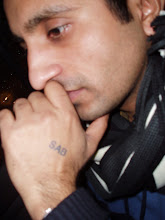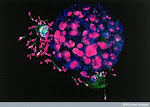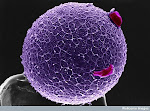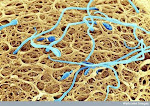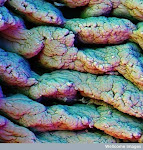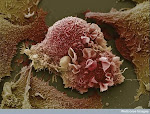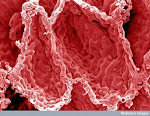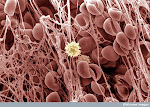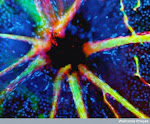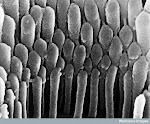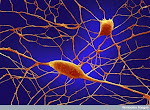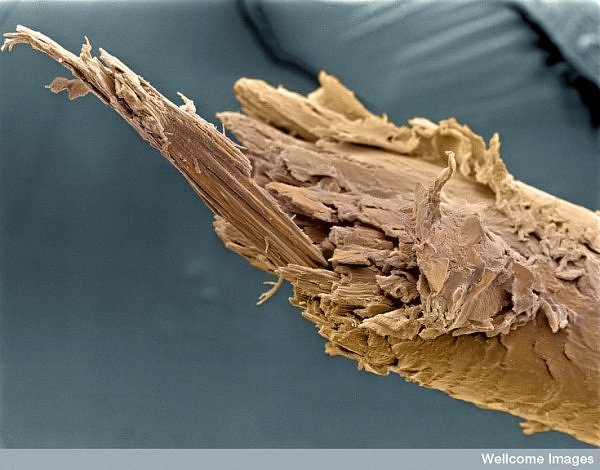Monday, May 23, 2011
Similarity between bacterial biofilm and embroyid bodies in stem cells
It would be interetsing in probe physico-chemical charcteristic governing the cluster formation in stem cells in form of embryoid bodies (EBs). Comapre it with recent paper (Epstein, A.K., Pokroy, B., Seminara, A. & Aizenberg, J. Bacterial biofilm shows persistent resistance to liquid wetting and gas penetration. Proceedings of the National Academy of Sciences 108, 995-1000 (2011)\)
Thursday, February 10, 2011
Making Microbial fuel cell chip (MFCC)
Monday, October 4, 2010
Indian lost test tube baby race to Edwards by 67 days Read more: Indian lost test tube baby race to Edwards by 67 days - The Times of India http://ti
CHENNAI: As news of a British researcher winning the Nobel prize for pioneering in vitro fertilization spread through the Indian scientific community on Monday, there was introspection about a lost opportunity which may have brought recognition for the work of Indian researchers.
On October 3, 1978, barely two months after the birth of the world's first IVF baby Marie Louise Brown, India had also produced its own — Durga alias Kanupriya Agarwal. Brown's scientific father, Robert G Edwards, professor emeritus at University of Cambridge and hailed as the father of IVF, has now been honoured with the Nobel prize in medicine.
But the West Bengal-based Dr Subhash Mukhopadhyay went on to face an inquiry by the West Bengal government in December 1978, before committing suicide on June 19, 1981, after the state refused to recognize his achievement. Senior scientists and gynaecologists across the country mourned his death on Monday and many urged the centre to correct a historical error by honouring him.
Mukhopadhyay devised the same technique as Edwards without knowledge of the parallel research in UK. The difference was that Edwards was 67 days ahead of him. Besides, the Indian did not have any collaborators nor did he document his work. "While Dr Edwards had documented every step right from animal studies, Dr Subhash had nothing. And in science, no claims can be proved without documents," said Dr Jayashree Gajaraj, former president, Federation of Obstetrics and Gynaecology Society of India (FoGSI).
"It hurts to see that the efforts of an Indian have gone unrecognised," said former Centre for Cellular and Molecular Biology chief Dr P M Bhargava, who was part of the committee that formulated the IVF lab guidelines.
Read more: Indian lost test tube baby race to Edwards by 67 days - The Times of India http://timesofindia.indiatimes.com/india/Indian-lost-test-tube-baby-race-to-Edwards-by-67-days-/articleshow/6687000.cms#ixzz11S49hE6P
On October 3, 1978, barely two months after the birth of the world's first IVF baby Marie Louise Brown, India had also produced its own — Durga alias Kanupriya Agarwal. Brown's scientific father, Robert G Edwards, professor emeritus at University of Cambridge and hailed as the father of IVF, has now been honoured with the Nobel prize in medicine.
But the West Bengal-based Dr Subhash Mukhopadhyay went on to face an inquiry by the West Bengal government in December 1978, before committing suicide on June 19, 1981, after the state refused to recognize his achievement. Senior scientists and gynaecologists across the country mourned his death on Monday and many urged the centre to correct a historical error by honouring him.
Mukhopadhyay devised the same technique as Edwards without knowledge of the parallel research in UK. The difference was that Edwards was 67 days ahead of him. Besides, the Indian did not have any collaborators nor did he document his work. "While Dr Edwards had documented every step right from animal studies, Dr Subhash had nothing. And in science, no claims can be proved without documents," said Dr Jayashree Gajaraj, former president, Federation of Obstetrics and Gynaecology Society of India (FoGSI).
"It hurts to see that the efforts of an Indian have gone unrecognised," said former Centre for Cellular and Molecular Biology chief Dr P M Bhargava, who was part of the committee that formulated the IVF lab guidelines.
Read more: Indian lost test tube baby race to Edwards by 67 days - The Times of India http://timesofindia.indiatimes.com/india/Indian-lost-test-tube-baby-race-to-Edwards-by-67-days-/articleshow/6687000.cms#ixzz11S49hE6P
Friday, October 30, 2009
भारतीय का कमाल, बनाया कैंसर रोधी डिश
लंदन। ब्रिटेन में भारत के शेफ ने एक ऐसा व्यंजन बनाने का दावा किया है जो कैंसर और डिमेंशिया [भूलने की बीमारी] जैसी बीमारियों से लड़ने में मददगार होगा। इस डिश की एक प्लेट की कीमत 2.5 पौंड [करीब 200 रुपये] होगी।
भारतीय मूल के 32 वर्षीय शेफ गुरप्रीत बैंस का दावा है कि चिकन, ब्लूबेरी और गोजी बेरी से बनी यह सब्जी और पिलाऊ राइस [विशेष प्रकार के चावल] एक ऐसा स्वास्थ्यवर्धक भोजन है जो कैंसर और अल्झाइमर्स के खतरों को घटा देता है।
एक व्यक्ति को परोसे गए इस व्यंजन में पालक के 49 पत्तों और अंगूर के 23 गुच्छों और ब्रोकोली के एक डंठल के बराबर पौष्टिक तत्व पाए जाते हैं।
उन्होंने बताया, दरअसल मसालेदार भोजन कैंसरजनित कोशिकाओं से लड़ने में सहायक होते हैं, जबकि अदरक, मिर्च लहसुन और हल्दी जैसे मसालों में बैक्टीरिया व वायरस रोधी गुण पाए जाते हैं।
गुरप्रीत ने कहा, मेरे द्वारा बनाए गए व्यंजन में कई स्वास्थ्यवर्धक वस्तुओं का समागम है जिसके नियमित प्रयोग से आप बीमारियों से कोसों दूर रह सकते हैं।
गुरप्रीत आहार विशेषज्ञ भी रह चुके हैं। वह पिछले दो सालों से पोषक व्यंजन बनाने के नए-नए प्रयोगों में लगे हैं। इसमें प्रयुक्त ब्लूबेरी में प्रोटीन अधिक मात्रा में पाया जाता है जिससे दिमाग मजबूत होने के अलावा कैंसर का भी खतरा कम हो जाता है। पिलाऊ राइस में विटामिन ए और सी के अलावा आयरन भी प्रचुर मात्रा में होता है।
उन्होंने बताया कि इसमें चिकन का प्रयोग इसलिए किया जाता है क्योंकि इसमें वसा कम होने के अलावा यह काफी पोषक होता है।
भारतीय मूल के 32 वर्षीय शेफ गुरप्रीत बैंस का दावा है कि चिकन, ब्लूबेरी और गोजी बेरी से बनी यह सब्जी और पिलाऊ राइस [विशेष प्रकार के चावल] एक ऐसा स्वास्थ्यवर्धक भोजन है जो कैंसर और अल्झाइमर्स के खतरों को घटा देता है।
एक व्यक्ति को परोसे गए इस व्यंजन में पालक के 49 पत्तों और अंगूर के 23 गुच्छों और ब्रोकोली के एक डंठल के बराबर पौष्टिक तत्व पाए जाते हैं।
उन्होंने बताया, दरअसल मसालेदार भोजन कैंसरजनित कोशिकाओं से लड़ने में सहायक होते हैं, जबकि अदरक, मिर्च लहसुन और हल्दी जैसे मसालों में बैक्टीरिया व वायरस रोधी गुण पाए जाते हैं।
गुरप्रीत ने कहा, मेरे द्वारा बनाए गए व्यंजन में कई स्वास्थ्यवर्धक वस्तुओं का समागम है जिसके नियमित प्रयोग से आप बीमारियों से कोसों दूर रह सकते हैं।
गुरप्रीत आहार विशेषज्ञ भी रह चुके हैं। वह पिछले दो सालों से पोषक व्यंजन बनाने के नए-नए प्रयोगों में लगे हैं। इसमें प्रयुक्त ब्लूबेरी में प्रोटीन अधिक मात्रा में पाया जाता है जिससे दिमाग मजबूत होने के अलावा कैंसर का भी खतरा कम हो जाता है। पिलाऊ राइस में विटामिन ए और सी के अलावा आयरन भी प्रचुर मात्रा में होता है।
उन्होंने बताया कि इसमें चिकन का प्रयोग इसलिए किया जाता है क्योंकि इसमें वसा कम होने के अलावा यह काफी पोषक होता है।
Sunday, October 18, 2009
Smart bandage to help diabetics
Danish doctors are developing a smart bandage to monitor wounds as they heal.
Created for diabetics, the bandage would be studded with tiny sensors and send data to clinicians via the net.
Invented at the Diabetic Foot Clinic, in Aarhus, researchers believe it could help diabetics keep feet healthy and avoid the risks of amputation.
Diabetes can mean poor circulation and nerve damage so that even small cuts or blisters on feet can go unnoticed and develop into a serious ulcer.
Distant diagnosis
Diabetics are advised to check their feet daily and seek early medical attention if there are any signs of damage.
Without timely treatment and monitoring, patients with such ulcers may need to have their toes, feet or even their entire leg amputated.
With a mobile phone connected to the intelligent bandage, the patient could go on holiday to another continent and still be monitored
Dr Niels Ejskjaer
Following a foot injury two months ago, diabetic patient Paul Hansen has been forced to attend weekly check-ups at the Aarhus clinic, 60km away.
Dr Niels Ejskjaer, head of the Diabetic Foot Clinic, believes that an intelligent bandage would cut the need for such visits.
"Modern technologies should be able to help us monitor patients like Paul remotely, and let us know what his condition is without a hospital visit," he told the BBC's Go Digital.
"If sensors were built into the bandage that would mean we could have information about the wound as it heals," he said, "its temperature, humidity, and perhaps even the types of bacteria present."
"This would allow the bandage to stay on for much longer and would save on the cost of medical care by avoiding unnecessary hospital visits," said Dr Ejskjaer.
Medical data from the intelligent bandage could easily be sent to the clinic, via phone or the internet.
Advances in wireless technology would allow for medical check-ups from anywhere in the world.
"With a mobile phone connected to the intelligent bandage, the patient could go on holiday to another continent and still be monitored," Dr Ejskjaer said.
Remote Control
Currently the idea is at the concept stage.
Although researchers in Aarhus have connected temperature and humidity sensors to a computer chip, they are currently too large to be practical.
Doctor monitoring treatment remotely
Doctors could use portable devices to monitor treatment
But Dr Ejskjaer believes the intelligent bandage is an idea that is ripe for exploitation in the telemedicine systems of tomorrow.
Already, more conventional telemedicine projects are under evaluation in Aarhus.
These have attempted to replace hospital visits with remote check-ups from the patient's home, using digital cameras to capture pictures of their feet and phone or internet connections to transmit these to the clinic.
Local nurses must still visit patients, to supervise the process as well as remove and replace bandages.
But an intelligent bandage, if it could be developed successfully, would remove the need for home visits, though for now the prototype is missing an important component - a digital nose.
Whilst most of us try to avoid proximity with other people's smelly feet, for a diabetic foot doctor those cheesy odours speak volumes on the health of our soles.
"Without a smell detector in the intelligent bandage," said Dr Ejskjaer, "we might miss a developing infection, which could be an important hurdle to overcome in our particular branch of telemedicine."
Created for diabetics, the bandage would be studded with tiny sensors and send data to clinicians via the net.
Invented at the Diabetic Foot Clinic, in Aarhus, researchers believe it could help diabetics keep feet healthy and avoid the risks of amputation.
Diabetes can mean poor circulation and nerve damage so that even small cuts or blisters on feet can go unnoticed and develop into a serious ulcer.
Distant diagnosis
Diabetics are advised to check their feet daily and seek early medical attention if there are any signs of damage.
Without timely treatment and monitoring, patients with such ulcers may need to have their toes, feet or even their entire leg amputated.
With a mobile phone connected to the intelligent bandage, the patient could go on holiday to another continent and still be monitored
Dr Niels Ejskjaer
Following a foot injury two months ago, diabetic patient Paul Hansen has been forced to attend weekly check-ups at the Aarhus clinic, 60km away.
Dr Niels Ejskjaer, head of the Diabetic Foot Clinic, believes that an intelligent bandage would cut the need for such visits.
"Modern technologies should be able to help us monitor patients like Paul remotely, and let us know what his condition is without a hospital visit," he told the BBC's Go Digital.
"If sensors were built into the bandage that would mean we could have information about the wound as it heals," he said, "its temperature, humidity, and perhaps even the types of bacteria present."
"This would allow the bandage to stay on for much longer and would save on the cost of medical care by avoiding unnecessary hospital visits," said Dr Ejskjaer.
Medical data from the intelligent bandage could easily be sent to the clinic, via phone or the internet.
Advances in wireless technology would allow for medical check-ups from anywhere in the world.
"With a mobile phone connected to the intelligent bandage, the patient could go on holiday to another continent and still be monitored," Dr Ejskjaer said.
Remote Control
Currently the idea is at the concept stage.
Although researchers in Aarhus have connected temperature and humidity sensors to a computer chip, they are currently too large to be practical.
Doctor monitoring treatment remotely
Doctors could use portable devices to monitor treatment
But Dr Ejskjaer believes the intelligent bandage is an idea that is ripe for exploitation in the telemedicine systems of tomorrow.
Already, more conventional telemedicine projects are under evaluation in Aarhus.
These have attempted to replace hospital visits with remote check-ups from the patient's home, using digital cameras to capture pictures of their feet and phone or internet connections to transmit these to the clinic.
Local nurses must still visit patients, to supervise the process as well as remove and replace bandages.
But an intelligent bandage, if it could be developed successfully, would remove the need for home visits, though for now the prototype is missing an important component - a digital nose.
Whilst most of us try to avoid proximity with other people's smelly feet, for a diabetic foot doctor those cheesy odours speak volumes on the health of our soles.
"Without a smell detector in the intelligent bandage," said Dr Ejskjaer, "we might miss a developing infection, which could be an important hurdle to overcome in our particular branch of telemedicine."
Material sciences at its best...............
http://news.bbc.co.uk/2/hi/science/nature/8313037.stm
A team of scientists from Italy and Sweden has developed what is believed to be the first artificial hand that has feeling.
It has been attached to the arm of a 22-year-old man who lost his own hand through cancer.
Researchers say it works by connecting human nerve endings with tiny electronic sensors.
A team of scientists from Italy and Sweden has developed what is believed to be the first artificial hand that has feeling.
It has been attached to the arm of a 22-year-old man who lost his own hand through cancer.
Researchers say it works by connecting human nerve endings with tiny electronic sensors.
Wednesday, October 14, 2009
खून का रंग बता देगा क्या है रोग!
वाराणसी [जासं]। रंगों की अपनी भाषा होती है। जरूरत तो इसे पकड़ने और पढ़ने की है। यदि बात खून और इसके बदलते रंगों की हो तो नि:संदेह यह कुछ नए आश्चर्य तो खड़े करती ही है। इस आश्चर्य को मूर्त रूप देने में जुटे हुए हैं काशी हिंदू विश्वविद्यालय के वैज्ञानिक।
वे ऐसा मालीक्यूल बनाने में लगे हैं जो खून के बदलते रंगों की मदद से किसी भी मर्ज के चेहरे से गुमनामी का पर्दा चाक कर देगा। सरल शब्दों में 'ब्लड टेस्ट' की तमाम क्लीनिकल पेंचीदगियों के दिन अब लदने वाले हैं। खून अब रंगों की भाषा बोलेगा और गुमनामी के चलते असाध्य साबित होने वाले रोगों के राज भी आसानी से खोलेगा।
अगर वैज्ञानिकों को इस मुहिम में सफलता मिल गई तो इससे नि:संदेह स्वस्थ समाज के सरोकारों को नया आयाम तो मिलेगा ही विश्वविद्यालय की ख्याति और बुलंद होगी।
'हार्स रैडिस परास्किडेज, एंजाइम' विकसित करने में जुटे रसायन विभाग के प्रो. एमएस सिंह कहते हैं कि रोगों को जानने के लिए तमाम तरह के उपकरण तो विकसित हैं पर उनका यह शोध खून को केंद्र में रखकर किया जा रहा है।
वह ऐसा मालीक्यूल यानी किट बनाने में लगे हैं जिस पर खून की एक बूंद डालते ही किट का रंग बदलने लगेगा। यह बदलता रंग ही रोगों की पहचान का आधार होगा।
इसके सिद्धांतों से मिशिगन डायग्नोस्टिक लिमिडेट [अमेरिका] को अवगत कराया जा रहा है और वहीं इसका परीक्षण भी हो रहा है। बतातें हैं कि अमेरिका की इसी संस्था ने यह प्रोजेक्ट भी सौंपा है, शोध जारी है। खून के जरिए एड्स, डायबिटीज, टाइफाइड, जांडिस, किडनी आदि के रोगों की जानकारी होती है। अभी इन सभी की जांच के लिए अलग-अलग व्यवस्थाएं है।
इस किट के उपयोग से खून की थोड़ी सी मात्रा मात्र से ही विभिन्न रोगों की जानकारी हो सकेगी। केवल इतना ही नहीं इसके माध्यम से शरीर की आंतरिक संरचना की गतिविधियों के बारे में भी जाना जा सकता है।
वे ऐसा मालीक्यूल बनाने में लगे हैं जो खून के बदलते रंगों की मदद से किसी भी मर्ज के चेहरे से गुमनामी का पर्दा चाक कर देगा। सरल शब्दों में 'ब्लड टेस्ट' की तमाम क्लीनिकल पेंचीदगियों के दिन अब लदने वाले हैं। खून अब रंगों की भाषा बोलेगा और गुमनामी के चलते असाध्य साबित होने वाले रोगों के राज भी आसानी से खोलेगा।
अगर वैज्ञानिकों को इस मुहिम में सफलता मिल गई तो इससे नि:संदेह स्वस्थ समाज के सरोकारों को नया आयाम तो मिलेगा ही विश्वविद्यालय की ख्याति और बुलंद होगी।
'हार्स रैडिस परास्किडेज, एंजाइम' विकसित करने में जुटे रसायन विभाग के प्रो. एमएस सिंह कहते हैं कि रोगों को जानने के लिए तमाम तरह के उपकरण तो विकसित हैं पर उनका यह शोध खून को केंद्र में रखकर किया जा रहा है।
वह ऐसा मालीक्यूल यानी किट बनाने में लगे हैं जिस पर खून की एक बूंद डालते ही किट का रंग बदलने लगेगा। यह बदलता रंग ही रोगों की पहचान का आधार होगा।
इसके सिद्धांतों से मिशिगन डायग्नोस्टिक लिमिडेट [अमेरिका] को अवगत कराया जा रहा है और वहीं इसका परीक्षण भी हो रहा है। बतातें हैं कि अमेरिका की इसी संस्था ने यह प्रोजेक्ट भी सौंपा है, शोध जारी है। खून के जरिए एड्स, डायबिटीज, टाइफाइड, जांडिस, किडनी आदि के रोगों की जानकारी होती है। अभी इन सभी की जांच के लिए अलग-अलग व्यवस्थाएं है।
इस किट के उपयोग से खून की थोड़ी सी मात्रा मात्र से ही विभिन्न रोगों की जानकारी हो सकेगी। केवल इतना ही नहीं इसके माध्यम से शरीर की आंतरिक संरचना की गतिविधियों के बारे में भी जाना जा सकता है।
Subscribe to:
Posts (Atom)


